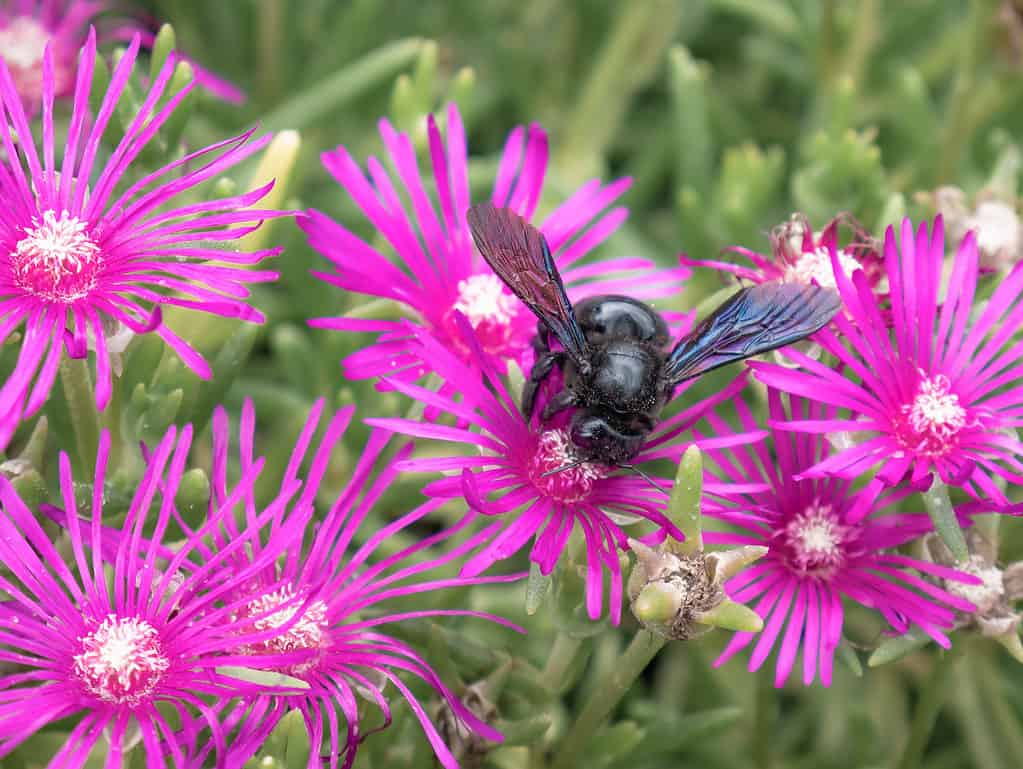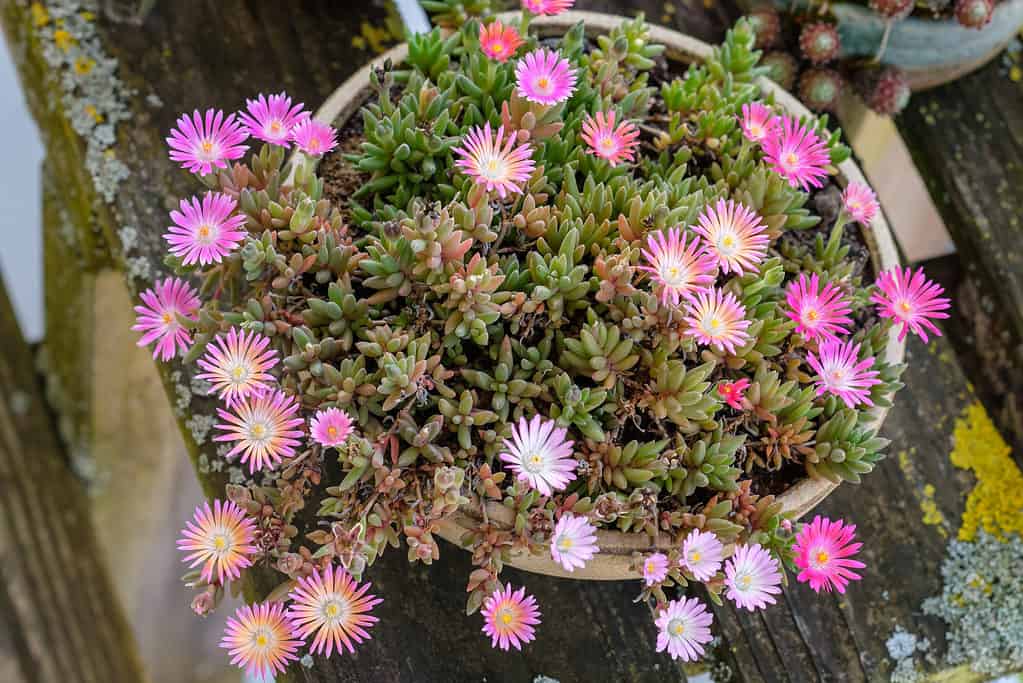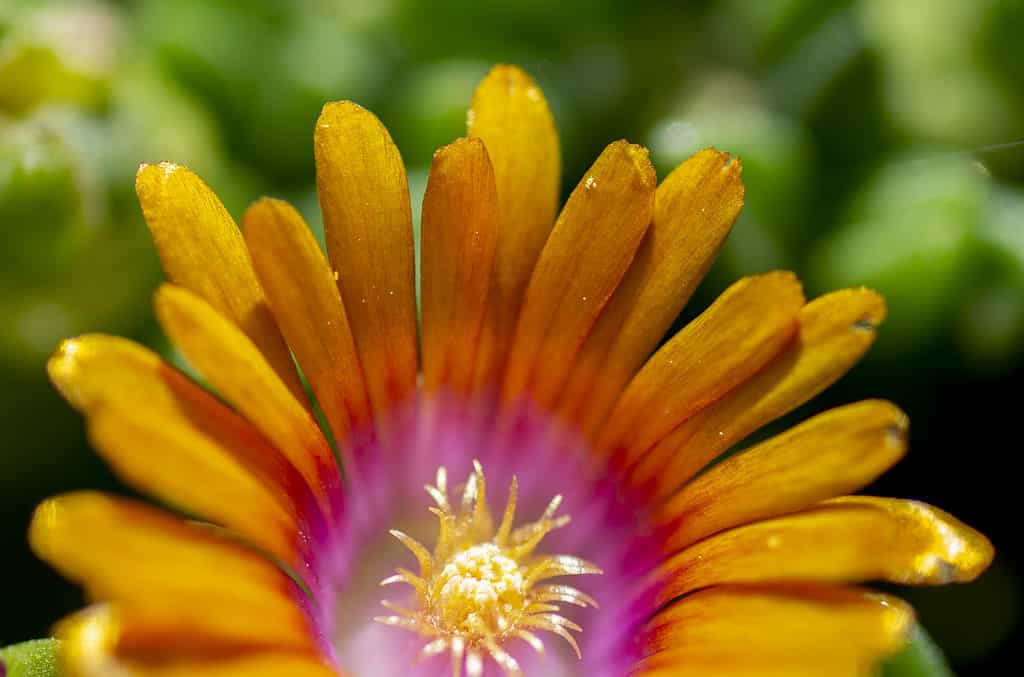As their name suggests, ice plants are more tolerant of colder temperatures than most succulent plants (although the common name “ice plant” may come from the tiny hairs on the plant that reflect light similar to ice crystals). These low-maintenance plants provide beautiful ground cover, making them a popular addition to many hillsides and gardens.
The taxonomy can be a bit confusing, as there are many genera and species commonly known as ice plants. A member of the Aizoaceae family, the most popular genus is Delosperma.
There is another common genus, Carpobrotus, that should be avoided as it is considered an invasive plant, especially on California’s coast.
Indigenous to the Drakensberg Mountains and the plateaus of the Great Karoo desert of South Africa, these cold-hardy plants can handle some pretty harsh conditions.
Ice plants grow 3-6 inches tall and spread quickly. They can double their ground coverage in the first year alone. In fact, a single ice plant can spread to cover over two feet of ground.
The vibrant blooms are bright and cheery and are also magnets for pollinators.

Ice plant blooms draw pollinators, such as this great carpenter bee.
©iStock.com/Dudbrain
The palette of colors is wide-ranging, including purple, pink, yellow, red, orange, and even bi-colored. The specific color will depend on the plant variety.
Ice plants require surprisingly little care to yield such gorgeous results. Here are the cold-hard facts about caring for this cold-hardy succulent.
| Ice Plant Facts | |
|---|---|
| Botanical name | Delosperma spp. |
| Common Names | Sea fig, sea marigold, vygie |
| Sunlight | Full sun |
| Soil | Sandy, well-drained |
| Water | Every two weeks |
| Indoors or Outdoors | Indoors in the direct sun of a south or west-facing window. Outdoors year-round in Zones 6-9. It can also be outdoors in Zones 4-5 if grown in containers that can be moved inside during cold weather months. |
Sunlight
The showy daisy-like blooms of the ice plant require a lot of sunlight. At least six hours of direct sun is needed each day.
Soil Type
These hardy succulents aren’t finicky and can grow in nutrient-poor soils. Drainage, however, is critical. Avoid clay soils. Rocky or sandy soils work well.
If planting in a container, use a mixture of equal parts potting soil and sharp sand or gravel for adequate drainage.
Water
When grown outdoors, the plant requires very minimal watering. If the weather is dry, watering once every couple of weeks may be needed. During the hottest months of summer, water the plant weekly if there is little rain.
Keep the plant dry during the winter. Watering during colder weather can lead to frost spots on the leaves. It can even be fatal for the plant.
If planted in a container, use the soak-and-dry method.
Placement
As noted earlier, this succulent provides wonderful ground cover. It needs space to spread out, so be sure to choose an area where individual plants can be spaced 12-18 inches apart.
Select a spot that receives ample sunlight and is not prone to standing water in rainy conditions.
When grown in a container, choose one with adequate drainage holes. The plant will spill over the sides of the container, making a lovely display of cascading color.

Ice plants fill and spill out of containers.
©iStock.com/photohomepage
The greatest challenge of growing this succulent indoors is making sure it receives adequate sunlight. Six hours of daily direct sun is the minimum. For this reason, it may not be the best choice for a year-round houseplant.
Ice plants are non-toxic to people and pets, so that is not a concern when deciding on placement. In fact, the leaves of the plant are edible, with a slightly-salty taste similar to seasoned spinach. The leaves can also be steeped as tea.
Propagation
Ice plants will often self-propagate when given adequate time and space. The plants will spread on their own and daughter plants will take root, separate from the mother plant.
They can also be propagated by division, which is most effective when done in the spring.
Simply dig up the plant, being careful to avoid root damage. Using a sharp spade, divide the plant in half at the roots. Replant each half in the same soil type as the original. Water each of the halves when replanting, and then return to the original watering plan.
Common problems
These succulents are relatively-problem free, with overwatering being one of the few more common issues. If the soil is too moist, it can lead to fatal root rot.
Aphids and mealybugs are drawn to ice plants, as they are to most other succulents. Neem oil is quite an effective treatment and deterrent. Insecticidal soap or diatomaceous earth also work well for pest control.

Different varieties of ice plants bloom in a host of different colors, including orange.
©iStock.com/Stefan Sutka
The hardiness, spectacular blooms, and simple propagation of the ice plant could make it a welcome and easy-to-care-for addition to your garden. Give it a try!
Up Next:
The photo featured at the top of this post is © iStock.com/Dr Juergen Bochynek
Thank you for reading! Have some feedback for us? Contact the AZ Animals editorial team.






